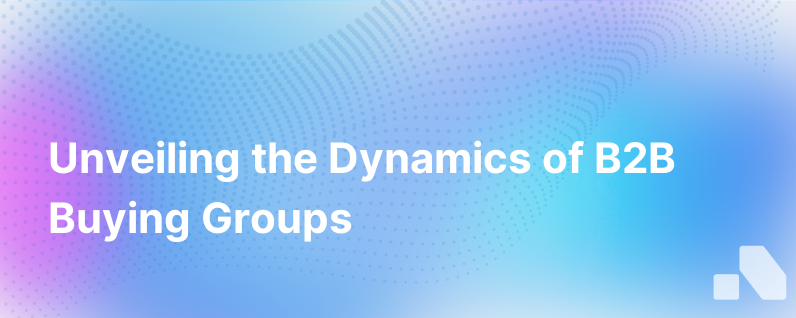Gaining Clarity Sort Of On B2B Buying Groups
Published on August 24, 2023 by Sawyer Middeleer
In-depth understanding of the complexity of B2B buying groups is pivotal for crafting a sales strategy that not only resonates but also converts. In the dynamic landscape of B2B sales, buying groups have transformed from a simple collection of individuals into a multifaceted organism with a tangled web of influences, priorities, and decision-making powers. Deciphering this web, although somewhat elusive, is a quest worth undertaking.
Let’s embark on a journey to demystify B2B buying groups and delve into practices that can bring some clarity to these often opaque entities.
The B2B Buying Group Explained
At its core, a B2B buying group consists of all the stakeholders involved in making a purchase decision. Unlike B2C transactions that generally involve one or two decision-makers, B2B interactions often require the nod from an ensemble cast, each with distinct roles and concerns.
Gartner research dissects the buying group into six archetypes:
- The Initiator: The person who triggers the buying process.
- The User: Final users of the product or solution.
- The Influencer: Impacts the decision with their expertise.
- The Gatekeeper: Controls the flow of information or access.
- The Decision Maker: Has the final say on the purchase.
- The Buyer: Manages the procurement process.
Understanding these roles is just scratching the surface. The dynamics within these groups can be unpredictable and changing members, shifting priorities, and varied buying cycles further cloud the waters.
The Challenges in Understanding Buying Groups
B2B buying groups are inherently complex due to several factors:
- Multiplicity: Groups often consist of 6 to 10 members, each with different agendas and criteria.
- Diversity: Members come from various functions, have differing levels of seniority, and can span multiple geographies.
- Changeability: The composition of the group can evolve as the buying process unfolds.
- Silos: Different departments might have siloed objectives which do not necessarily align with each other.
- Information Overload: Abundant data from varied sources influence the group, complicating consensus building.
Gaining clarity can feel like an impenetrable fog, but with sharp focus and strategic insights, it’s possible to cast a light on the key players and decision-making mechanisms within these groups.
Approaches to Gaining Clarity
Direct interactions with the buying group are rare and precious. Yet, there’s a lot that can be done on the backend to sharpen your understanding. Here’s how:
Conduct Thorough Research
Knowing your customer has never been more nuanced. Dive beyond the surface-level analysis. Real-time data analytics offer detailed insights into company news, strategic initiatives, and financial health, which could signal understanding the subtleties of buyer behavior.
Utilize Advanced Tools
In the age of AI and machine learning, sales intelligence platforms can track patterns and preferences in real-time, providing a clearer picture of buyer group dynamics. Automated tools can assess historical purchase data, social listening, and CRM insights to forecast possible influences on the buying group.
Leverage Account-Based Marketing (ABM)
ABM strategies tailor marketing initiatives to specific accounts, focusing on the collective needs of the buying group rather than individual leads. It offers personalized engagement plans, crafting messages that resonate with the concerns and challenges of the group.
Encourage Cross-Departmental Collaboration
Sales, marketing, and customer service teams should work in harmony, sharing insights and data to map out the stakeholders and their possible motivations. Viewing the group from different angles can fill in many blind spots.
Engage Multiple Contacts
Building multiple relationships within an account can provide a 360-degree view of the buyer group. Each contact point can provide unique insights, offering a more comprehensive understanding of the collective decision-making process.
Listen and Adapt
Every interaction with the buying group is a learning opportunity. Pay attention to the feedback, both explicit and implicit. Improving your pitch and adapting your offering in response to the group's reaction can not only enhance clarity but also demonstrate responsiveness and flexibility.
Examples of Gaining Clarity in Action
Many companies have reaped the rewards of investing in gaining clarity on B2B buying groups. For instance, by implementing ABM strategies, a SaaS company managed to align its marketing messages with the specific pain points of each stakeholder within a buying group. The consequence was a decrease in the sales cycle length and an increase in the average deal size.
Similarly, by leveraging a sales intelligence platform, another B2B enterprise successfully identified new decision-makers who joined the buying group mid-cycle, enabling them to adjust their engagement strategy in real-time. By continually mapping relationship changes, they closed deals 20% faster than before.
Conclusion
Navigating the murky waters of B2B buyer groups requires a combination of patience, keen observation, and an appetite for data. It’s an almost cryptographic challenge – deciphering the diverse and shifting codes of buying groups.
While complete clarity might be something of a mirage, each step toward understanding these complex entities can spell the difference between a lost opportunity and a successful sale. The effective deployment of sales intelligence tools, ABM practices, interdepartmental collaboration, and adaptive learning can illuminate the path through the fog.
As in many aspects of business, the clarity gained in understanding B2B buying groups does not come from a singular moment of enlightenment, but rather from an ongoing commitment to learn and adapt to the nuances of group buying behaviors. For those up to the challenge, the rewards can be substantial.
By aligning your sales approach with the intricacies of buying group structures, your strategies will resonate more deeply, fostering stronger, more enduring connections that nurture business growth. And while no single article or guideline can strip the complexity away entirely, those who consistently strive to understand and adapt will undoubtedly navigate the B2B landscape with greater success.